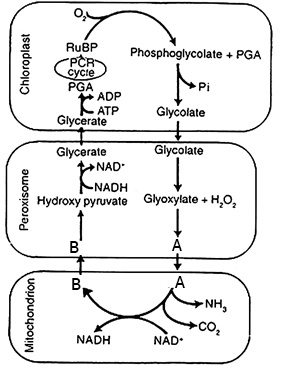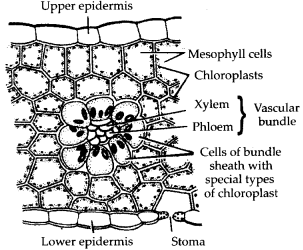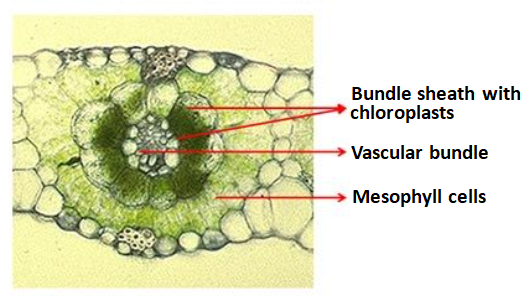Chemiosmosis in chloroplasts is possible because of:
1.
establishment of a proton gradient across the thylakoid membrane.
2.
diffusion of electrons through the ATP synthase.
3.
osmosis of water from thylakoid to stroma.
4.
presence of large amount of oxygen in the stroma.
Given below is the schematic diagram of photorespiration pathway. The molecules labeled as A and B are respectively:

1. Serine and Glycine
2. Glycine and Serine
3. Glycine and Alanine
4. Alanine and Glycine
The pH of the space of thylakoid of isolated chloroplast is decreased and then transferred in the dark to a pH-8 solution. The result would most likely be:
I. The isolated chloroplasts will make ATP.
II. The Calvin cycle will be activated.
III. Cyclic photophosphorylation will occur.
1. Only I
2. Only I and II
3. Only I and III
4. Only II and III
Photorespiration rates are increased by:
I. lowered availability of carbon dioxide
II. increased availability of oxygen
III. increased temperature
| 1. | Only I and II | 2. | Only I and III |
| 3. | Only II and III | 4. | I, II and III |
The ATP synthase complexes in a plant cell are located:
| I: | in the thylakoid membrane |
| II: | in the plasma membrane |
| III: | in the inner mitochondrial membrane |
| 1. | I and II only | 2. | I and III only |
| 3. | II and III only | 4. | I, II and III |
A possible purpose of photorespiration may be:
1. assimilation of nitrate from the soil
2. translocation of carbohydrates
3. enhanced PGR efficiency
4. differentiation of plant cells
The following diagram shows bundle sheath cells with “special” types of chloroplasts. What is special about them?

1. They are larger than normal size
2. They are agranal
3. They are dimorphic
4. Calvin cycle cannot take place in them
In chloroplasts, protons are actively pumped from
1. the intermembrane space to the matrix.
2. the matrix to the stroma.
3. the stroma to the thylakoid space.
4. the thylakoid space to the intermembrane space.
The following diagram shows the photosynthetic carbon cycle. A and B can respectively be:
1. Pyruvate; malate or aspartate
2. Phoshoglycerate; fumarate or aspartate
3. Phosphoenol pyruvate; malate or aspartate
4. Phosphoenol pyruvate; fumarate or aspartate
The relationship between photosynthesis and respiration can be best described as:
| 1. | Photosynthesis and respiration are reversal of each other in biochemical pathways. |
| 2. | Photosynthesis stores energy in complex organic molecules, while respiration releases it. |
| 3. | Respiration occurs only in animals and photosynthesis occurs only in plants. |
| 4. | Respiration results in formation of ATP but photosynthesis can only use them. |




